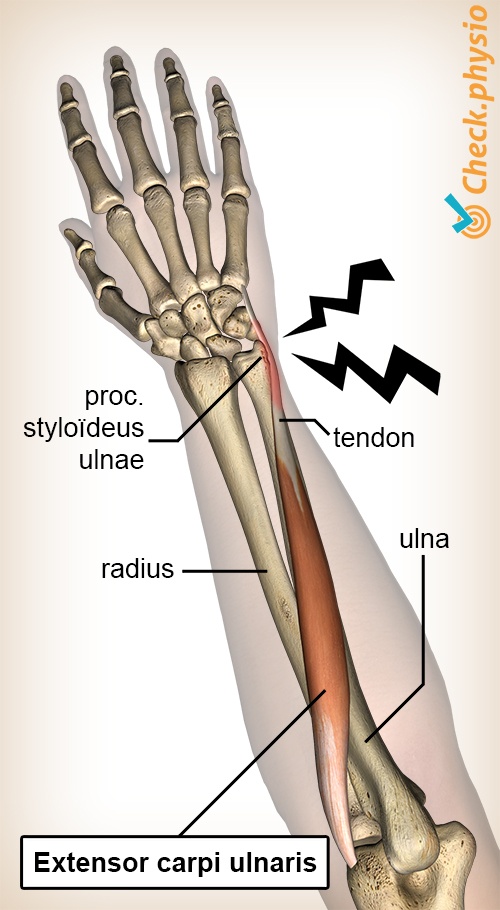- Conditions
- Extensor carpi ulnaris tendinopathy
Extensor carpi ulnaris tendinopathy Extensor carpi ulnaris tendinitis
Introduction
In this tendinopathy, the tendon of the muscle known as the "extensor carpi ulnaris" is affected. Often the tendon is inflamed through overuse. The symptoms are located on the top of the wrist, at the base of the little finger.
The tendon of the extensor carpi ulnaris runs along a bony nodule (the ulnar styloid process) located on the top of the wrist. This is the site where the pain is generally felt.

Description of condition
The extensor carpi ulnaris tendon ensures that the wrist can be stretched and at the same time bent toward the little finger side. In addition, this tendon is also important for the stability of the wrist joint. The tendon runs through a tunnel of connective tissue. This tunnel holds the tendon firmly in place.
The forearm has the ability to turn the palm of the hand upward. This movement is called supination. The tendon can become locked during the supination movement of the wrist. This generally happens when done in combination with bending the wrist and moving sideways toward the little finger side.
Cause and history
The symptoms usually occur gradually as a result of overuse. Extensor carpi ulnaris tendinopathy is common in tennis players (racket sport players), baseball players, golfers and rowers.
Signs & symptoms
- Pain on the upper little finger side of the wrist.
- Swelling (of the tendon) sometimes occurs.
- Pain when stretching the wrist against resistance, particularly if the wrist is simultaneously bent toward the little finger (ulnar deviation).
- The tendon may be sensitive when pressed.
Diagnosis
The diagnosis is made on the basis of the patient's story and a physical examination. The strength, mobility and stability of the wrist are reviewed. Sportsmen should also be checked for possible causes such as poor technique (for example, a tennis stroke).
An ultrasound or MRI can provide insight into the nature and severity of the symptom. This is especially important if the treatment does not yield progress or does not work adequately. The anatomy on the little finger side is very complex and there can be many individual differences. The tunnel through which the tendon runs may also cause problems.
Treatment and recovery
Usually rest, possibly with a wrist brace, is sufficient to let the symptoms subside. After that, it is important to rebuild strength, coordination and mobility around the wrist and to tackle the cause of the symptoms.
In addition, the mobility of all the small bones in the wrist area is often examined. These bones should be able to move properly separately from each other. If there is no mobility in this area, the tendon may become strained because it has to work harder.
For athletes, it is important that the equipment and technique are also reviewed. This could mean restringing a tennis racket or improving technique.
More info
You can check your symptoms using the online physiotherapy check or make an appointment with a physiotherapy practice in your locality.
References
Parmelee-Peters, K., Eathorne, S.W. (2005) The wrist: common injuries and management Prim Care. 2005 Mar;32(1):35-70.
Campbell, D., Campbell, R., O'Connor, P. & Hawkes, R. (2013) Sports-related extensor carpi ulnaris pathology. A review of functional anatomy, sports injury and management Br J Sports Med 2013;47:1105-1111.
Schünke, M., Schulte, E. & Schumacher, U. (2005) Prometheus. Algemene anatomie en bewegingsapparaat Houten: Bohn Stafleu Van Loghum.
Gerritsen, B.J. & Heerkens, Y.F. (2004) Anatomie in vivo van het bewegingsapparaat Maarsen: Elsevier gezondheidszorg.
Montalvan, B., Parier, J ., Brasseur, J.L., Le Viet, D. & Drape, J.L. (2006) Extensor carpi ulnaris injuries in tennis players: a study of 28 cases Br J Sports Med 2006;40:424–429.
